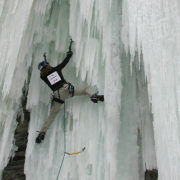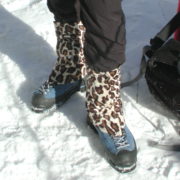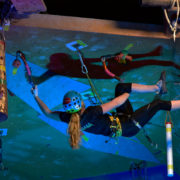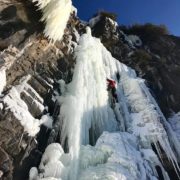Festiglace Friday #3
/4 Comments/in Events, Featured Stories/by NEice AdminCompetitors compete for the greatest climber award – Festiglace, Pont-Rouge Quebec.
Festiglace 2020
/7 Comments/in Events, Featured Stories, Ice Climbing News/by NEice AdminThe Return of FESTIGLACE
Feb. 21-23, 2020
After an absence of over a decade, Festiglace is back and ready to stoak the ice climbing fever again in Pont-Rouge, Quebec. Thanks to the team of passionate volunteers that have brought this event back for everyone to enjoy.
Festiglace was my favorite ice climbing festival in the Northeast and I am so glad it is back. Held in the spectacular setting of the Jacques-Cartier River where grade 5 & 6 ice climbs are a dime a dozen, it is a dream location for an ice climbing event.
Stay tuned to NEice throughout the season for more information on Festiglace 2020
Full Press Release here… Festiglace 2020
Web site – http://www.festiglace.org
Festiglace Friday
Every Friday till Festiglace 2020 I will be posting photos from my archives. I attended all 10 of the previous festivals and have many great photos to share. I will start off with this spectacular photo of Abby Watkins competing during Festiglace 2001. The harder the climb, the more points you receive. It was a cold day and the ice was hard and dry. Not an easy climb, but worth big points. This climb was first climbed the day before by Rich Marshall. It goes up and left. He rated it WI7.
Doug Millen
Climber Profile: Shawn Bunnell
/0 Comments/in Climber Profile, Featured Stories, Front Page/by AldenIn the past two seasons, Bunnell has been quietly ticking off some of the region’s hard traditional classics and has been on a tear recently.
#smuggsicebash2019
/0 Comments/in Events, Featured Stories/by NEice AdminThe 2019 Smuggs Ice Bash Drytool Comp. at Petra Cliffs. Photos & Results
Apex Predator
/0 Comments/in e-guide, Featured Stories, Front Page, New Ice Climbs/by NEice AdminKevin MacKenzie, aka “MudRat” of www.adirondackmountaineering.com gives us a tour of “Apex Predator” in the remote Panther Gorge
This Dangerous Game
/10 Comments/in Featured Stories, Front Page 2, Teck Tips/by AldenConfessions of an Ice Climbing Junkie
Most of my heroes are dead. I have been ice climbing for over twenty-five years. Climbing is a dangerous game but ice climbing and alpinism are even more so. Well-known climbers like Guy Lacelle, Ueli Steck, Craig Luebben, Alex Lowe, Sue Nott, and Karen McNeill had a big impact on me. I still hold them all on a high pedestal, but they are gone. A very good friend lies in the hospital right now fighting for his life. I shed tears thinking about it. Yet despite all this, I still want to climb ice and to climb hard.
We all struggle with this danger to some degree when we snap on our crampons, pick up tools, and head up a climb. Hopefully, we immediately start weighing on our previous experiences, comparing ice conditions from last week or last year, assessing our fitness level, questioning how confident we are in ourselves and our partner, and maybe even pondering how many beers we had the night before. But maybe we don’t always give enough thought as to what could happen and, in the end, our self-confidence and desire win out.
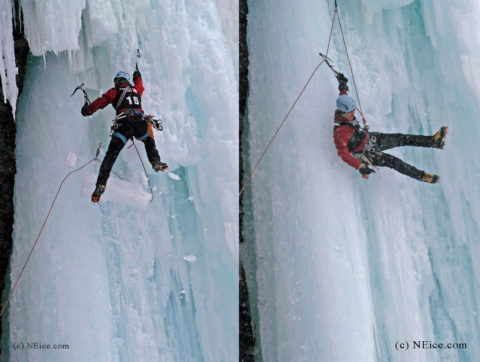
Guy Lacelle takes a lead fall during a competition at Festiglace in Quebec. A block of ice unexpectedly caught his rope. Guy was on steep ice and fell on to a single well-placed screw. Lucky! If that screw had failed he would have hit the deck.
Ice climbing is different than rock climbing. Good gear is never really ever guaranteed and neither is solid ice. What was great this morning is garbage an hour later. As we climb, we tune in to feel every creak while cranking a screw into the ice and every muscle complaining about the time it’s taking us to place the gear. Our minds are on hyper-alert as the handle spins too easily, finding that big air pocket just under the surface, telling us it’s worthless as gear and your extra exertion to improve safety was just a waste of time. Maybe you clip it anyway and keep climbing. Four more screws like that and you find yourself desperately hanging onto your tools, toes going numb from the cold, lungs sucking dry wind, arms aflame, and fear starting to dig in, leaving you feeling like a mouse in a hawk’s talons.

Ben Maxfield plays it safe by putting in another screw off the belay while leading on Called on Account of Rains (WI5+) at Lake Willoughby in Vermont.
Don’t fall. There it is. The cardinal rule of ice climbing. Just top-roping a dozen times on the steep pillar at the local crag doesn’t prepare you for the commitment of leading ice. Dry-tooling at the gym won’t show you what a good, safe tool placement is. It takes years to learn to accurately read ice conditions, and ideally, you should be better than a cabinet-maker who knows how to work the grain in each piece of wood just by looking at it.
Since I first started climbing ice over twenty-five years ago, one major thing that has really stuck with me through the years was a piece of advice that came from ice climbing legend Joe Josephson: “Treat every tool placement like it was an anchor.” The idea was to never settle for less than a perfect one, because as you move up, if you don’t have complete confidence in the last one you’re hanging from, you will make progressively worse placements and eventually fall. This means testing your placements before moving up on them. Not a weak little tug—yank down on it. Make sure it’s not going to blow if you accidentally twist it a little. And you will eventually twist it. A foot might blow. Your gear loop will catch on an icicle as you move up, throwing you off balance. The column you just stemmed out to will collapse and snag your lead rope.
“Treat every tool placement like it was an anchor.”
Warm weather and sun are among the biggest enemies of ice climbers. Too often people are wooed by soft, friendly ice as the temps soar above freezing. Just because it’s still standing doesn’t mean you should climb it. A partner and I once watched the upper part of Mindbender (WI5+) at Lake Willoughby in Vermont come crashing down like a building demolition team had dropped it. Not a sound emanated from an upper section the size of a semi-truck until it pounded itself into hundreds of shards, roaring as it scattered shrapnel down the gully, damaging trees as it went. We had been standing right there an hour earlier planning to climb it. As soon as the sun came out and we felt the penetrating heat, we headed for the shadier neighboring route, Renormalization (WI4). That decision clearly saved our lives.
I’ve soloed Bridal Veil Falls (WI5+) in Colorado, Mindbender (WI5+) and Called on Account of Rains (WI5+) at Lake Willoughby, and dozens of other hard ice routes around the country, Quebec, and Newfoundland. But, unashamedly, I’ve also bailed off countless easier routes halfway up. I’ve hung on screws to shake out while leading. I’ve downclimbed when things didn’t look good. I’ve even just walked away from a chosen route because my partner and I just weren’t feeling the mojo that day. Yup, something just felt wrong. One recent year, I even backed off a WI3 I have done probably a hundred times, all because it had a brittle narrow section that looked like WI6 that day. It just didn’t look worth it.
Two years ago, I broke the cardinal rule. Until then, I was proud of the fact I hadn’t fallen on a regular ice route in over twenty years. But I fell and I fell big. My own cloud of ambition led to a dangerous fall.

Canadian hardman Yan Mongrain leading out the top pitch of “Mindbender”(WI5+) in good conditions at Lake Willoughby in Vermont.
Andrea Charest and I had arrived at Lake Willoughby in Vermont with a big goal, determined to climb three big 5+ routes in a day. We were psyched! Conditions were perfect. The day was overcast and reasonably warm. It was 30 degrees F with mostly sticky ice. We had this already, I thought! She and I would swap leads through the day. We headed straight up from the road to Mindbender. Soon racked and ready, Andrea led up the first pitch, confidently working her way through the big overhanging mushrooms with strength to spare. From her work as an experienced guide, she quickly set up a solid anchor at a stance in a protected corner of ice below the aerated upper column and brought me up. Clipped into the anchor, I leaned out and looked up. Even the easiest line above was gnarly-looking and intimidating. I’d done the route many times, so I pushed away any doubts. After all, no time to waste: we had two more routes to do after we finished this one.
With a high-five from Andrea, I started up. The pitch was solidly in WI5+ territory. The beginning offered a pumpy overhanging bulge with bad feet. It led into aerated, weird fins of ice that offered some crappy tool placements and poor protection but hopefully getting into some good stemming opportunities. I was feeling the workout now, but I was shaking out regularly and reminding myself to breathe. I moved off a couple of sketchy placements after testing each one and moving as smoothly as I could; matching on a tool, I reached up to hook my way into the stemming corner. After a couple more heady moves, I discovered what from below looked decent, but now I was perched on a three-foot-wide, two-inch-thick window of ice with water gushing behind it. I had maybe four screws in below me. Maybe one was good. I could hear the water pounding down behind the sheet of clear ice. I placed a screw in some thicker aerated ice off to the side, trying to avoid tapping into the gusher. It looked good, but who really knows?
“It looked good, but who really knows?”
I continued up carefully, gently placing a front point into a divot left by an earlier tool placement. More delicate moves, testing each one, pulling straight down on it, my elbow touching the ice. Ten more feet and I made it into thicker solid ice, but now pale and rotten-looking. I cranked a long screw into the frozen sugar. The top-out was now tantalizingly close. The screw would have to do. There wasn’t time for more. I needed to get to the established belay tree, so we could rappel and get after the next route. I thunked my way up another ten feet and found only wet rock at the top, the water running down behind the ice. There was no way to access the frozen turf above. I scratched uselessly around on the rock, but feeling a little pump coming on, I down-climbed back to the screw. It was fruitless to go that way.
Looking out right, I eyed a horizontal finger of overhanging detached ice. I knew I could get up to another tree out that way. I could see frozen dirt above the ice. The feet were clearly sketchy. I’d done this stuff before, though. I needed to get to the tree; we had two more routes to do. I began hooking my tools in the space behind the top of the detached overhanging ice. Digging my front points into a smear of ice below, I drop-kneed and stretched up to reach higher, swinging hard into the frozen turf. It squished. It was just mush. Sucking in a deep breath, I stepped up higher and drop-kneed again. I swung and heard that solid thunk as the pick buried into a solid patch, partly of ice and partly old tree stump. I tugged hard. The placement felt good. Of course, it was good. I confidently unhooked my other tool from the ice finger and pulled it back to swing. Maybe one more move and I’d be at the tree.
In an instant, that one tool ripped away.
As a longtime ice climber, you know that falling will end badly, possibly even deadly if the gear fails. You should never fall. My mind pondered over what just happened. That tool placement was good, wasn’t it?
“So, this is how it ends, I thought, marveling at the blue beauty of the ice as I kept falling.”
Free from the counter pressure, my legs uncoiled, propelling me outward in an arch. Over what seemed like minutes, I slowly drifted, spinning upside down. So, this is how it ends, I thought, marveling at the blue beauty of the ice as I kept falling. The screw wouldn’t hold. I came around, almost upright now, still calmly waiting for The End. The hiss of rope through carabiners ripped into my eardrums. Air rushed into my lungs. Time sped up. My legs wrenched around violently. With the harness biting into my gut, I stopped.
My feet gently brushed a huge blobby ledge of ice as I realized the last screw had held. Everything held. Andrea had been yanked off her feet, but the anchor was solid, and she was unhurt. The chaos was gone. Life was normal. Not a scratch. Fate had been oh-so-good to me.
I climbed back up through all the difficulties to the last screw. Putting my ego away in a box, I put in another two screws, built an anchor and called that the top. We rappelled off a thread in the ice and walked back down to the road. She led everything the rest of the day.
I relearned many important lessons that day: 1) Check your ego. It’s good to have confidence but be realistic; 2) If it looks dangerous, it probably is; 3) Be twice as strong as you think you need to be; 4) Sometimes the top isn’t the realistic top; 5) Quit while you’re ahead (see the previous lesson); 6) Just because someone else did it doesn’t mean you have to; 7) Some days it’s just better to leave early and go have a beer.
They aren’t guarantees of safety, but they keep the odds in your favor. I still seek to climb hard, but I try to think more about what can happen. I hope you all do, too.
~ Alden Pellett
More Ice Climbing Safety Tips:
Canadian ice climber Will Gadd has a great set of tips for climbers: http://willgadd.com/note-to-self-how-not-to-fall-off-ice-climbing/
Petzl offers some tips and techniques: https://www.petzl.com/US/en/Sport/News/2015-11-16/Tips-and-techniques-for-ice-climbing
Finding Big Ice in Newfoundland
/0 Comments/in e-guide, Featured Stories, Front Page/by AldenA Climber’s Guide
by Alden Pellett
I opened the door to the sound of howling wind, blasting horizontally in front of the cabin loaded with fresh snow that felt like sandpaper on my face. The thought of ice climbing in this harsh below-zero weather made my gut turn. I closed the door, turning to my climbing partner Ryan, “We’re going to need more hot tea.”
For us, that was an early experience on the road to discovering the ice climbing potential in Newfoundland. We had arrived in mid-January that year, learning the hard way by enduring a long sub-zero cold snap with nasty winds that convinced us that it’s better to go later in the season. Before we left on the trip, Joe Terravecchia, one of the earliest pioneers of ice climbing in Newfoundland and whose slide show on climbing in the area had whet our appetites, had not offered up much beta, leaving us to discover what we could as we went.
“The striking Cholesterol Wall, an intimidating steep rock shield often covered in overhanging fat-like ice blobs”
Motivated by those tales of huge remote ice climbs, my friend Ryan Stefiuk and I had piled all of our climbing gear into my rig and headed out from Vermont. We drove out across Maine, through New Brunswick, and out to the tip of Cape Breton Island in Nova Scotia. There, in North Sydney, as we drove onto the massive overnight ferry late in the evening, a ferry worker motioned us forward as we followed the line of heavily loaded semi-trucks down into the belly of the beast. We awoke the next morning in the upper deck to the sound of ship engines rumbling as we arrived in Port aux Basques, Newfoundland, relieved that we hadn’t experienced one of the legendary boat-tossing, vomit-inducing, heavy sea crossings the route can occasionally produce.
Hunting down where to ice climb in Newfoundland has never been easy. Information on first ascents and route beta has always been difficult to get from previously closemouthed visitors who were possibly hoping to keep the area quiet, to keep potential first ascents to themselves, and to maintain a sense of adventure for others, leaving other first-timers feeling more like they were on an expedition. In fact, this tight-lipped ethic has led to more than one climbing team declaring first ascents, only to find that the routes had been climbed years earlier.
On that first trip ten years ago, Ryan and I eventually found our way to the coastal town of Rocky Harbour. Along the way, the scenic windswept coastal lands scattered with stunted spruce trees that sprouted branches growing only on the downwind side hinted at severe weather. One highway sign along the way warned drivers of poor visibility and dangerous winds over 100 kilometers per hour.
Arriving there in the small fishing village near Gros Morne National Park, we soon learned that the prime area in the region, full of the huge classic ice climbs we had dreamed of, was Ten Mile Pond.

The Cholesterol Wall, a steep wall that is host to a collection of big world-class ice and mixed climbing routes at Newfoundland’s Ten Mile Pond.
This deep freshwater fjord just outside of Rocky Harbour is home to dozens of big classic winter routes of world-class quality, from 600 feet long to near-Alaskan proportions of 2000 feet in length – many of which have only seen one ascent. Each of these stunning routes is every bit as classic as Quebec’s legendary 800-foot La Pomme D’ Or (WI5) or Polar Circus (WI5) in the Canadian Rockies.
The area is also home to the striking Cholesterol Wall, an intimidating steep rock shield often covered in overhanging fat-like ice blobs. The fat theme plays out on routes with names like Fat of the Land and Tundering Lard, both WI5+ and over 800 feet tall.
Thanks to a relatively accessible location with good comfortable lodging nearby and very friendly locals, this beautiful backcountry destination should eventually be on every serious ice climber’s tick list.
To help open the door for NEIce readers to find their way to this incredible spot, and actually enjoy the weather instead of fighting it, we’ve compiled some past stories and photos along with some good beta.
Stories on Newfoundland Ice Climbing:

Chat Bots – AI for Ice Climbers
Chat Bots – Al for the Ice Climbers

Climbing Dreamline in Newfoundland
Dreamline (WI6+, 1,260′) February 21, 2017 Gros Morne National Park, Newfoundland, Canada Joe Terravecchia,Will Mayo and Anna Pfaff climbed a new, and spectacular line today, “Dreamline” (WI6+, 1,260′). Dreamline is a spray ice climb to the right of The Pissing Mare Waterfall on Western Brook Pond. Joe and Casey Shaw have been dreaming of, and eyeing this line since 1997, waiting […]
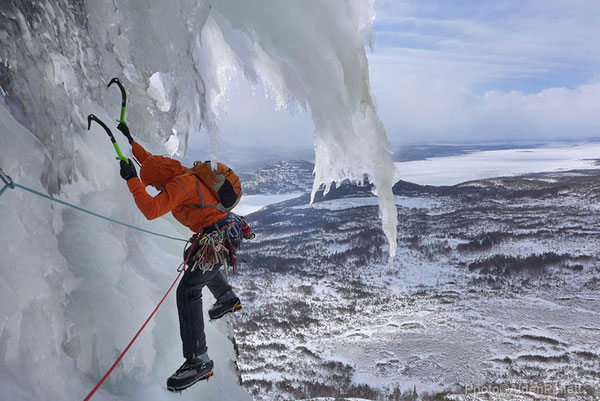
Newfoundland 2015
A Trip Report by Ryan Stefiuk – bigfootmountainguides.com The MV (marine vessel) Leif Ericson crunches through sea ice in the Cabot Strait. The ship’s hull groans and 2-3 meter thick ice buckles underneath. Cracks in the ice expose the intimidating midnight blue waters of the North Atlantic. I see the long low hills of the […]

Lard Tunderin’ Jaysus, Der’s A Lotta Ice Up Der B’ys!
by Ryan Stefiuk I buried my face inside my puffy coat as Andre’s snowmobile lurched into motion. The rubber tread beneath us occasionally slipped on the thick black tiles of ice as we sped along the pond. To my right, Alden and Walt were cruising along, closer to the shoreline. The Cholesterol Wall, looming just […]

Road Trip – Newfoundland Ice 2012
Newfoundland Ice by Michael Wejchert “Walt Nichol, man of few understandable words, slows the snowmobile to a stop about twenty feet form my battered Toyota Corolla and I jump out. For the third time in as many days, Alden Pellett, Ryan Stefiuk and I thank Walt and step out of his cedar sleigh. We’ve all […]
http://www.alpinist.com/doc/web07-08w/newswire-menard-mongrain-newfoundland
http://www.alpinist.com/doc/web15w/newswire-mayo-pfaff-new-route-newfoundland
How to Get There:
The best and cheapest way to get to Newfoundland is really to drive your own car. Yes, it’s a long drive!
Otherwise, fly into St. John, NL, and either rent a car there (A nine-hour drive to Rocky Harbour) or arrange an additional flight to Deer Lake, NL, where you can rent a car from any one of the major rental agencies. From there, Rocky Harbour is just an hour away.
Driving Directions:
If you are coming from most areas of the Northeast, get yourself to Bangor, Maine. From here, it is 550 miles out to North Sydney, Nova Scotia. From Bangor, take Maine State Rte. 9 across the southern part of the state. Cross the Canadian border to follow New Brunswick Rte. 1E (NB-1E) nearing the Bay of Fundy and eventually through Saint John, where the road heads more inland. Near River Glade, merge onto the Trans-Canada Hwy (NB-2E) and continue past Moncton, NB, where the highway starts heading more southerly finally reaching Nova Scotia, where it becomes NS104E. Eventually, the road becomes NS105E. Follow signs for Trans-Canada Highway/Cheticamp/Baddeck/Sydney. In North Sydney, turn right onto Orangedale Road (signs for Marble Mountain/Lona). Turn left onto Portage Road, then turn right onto NS-223 E (signs for Lona/Grand Narrows/North Sydney). Finally, continue onto Seaview Drive/NS-305 N. Once you are in the parking area for the ferry, you will find a terminal with bathrooms. Be prepared for a long wait if seas are rough. It is best to buy your tickets well in advance. You should arrive at least three hours before departure time.
Board the ferry for an overnight journey to Port Aux Basques, Newfoundland. Get your tickets and find the schedule and other information here: https://www.marineatlantic.ca/en/plan-your-travel/ferry-rates/
The Marine Atlantic ferry has overnight cabins with beds and a bathroom/shower, or you can go cheaper and opt for one of the less private bunkbeds. There is a cafeteria serving decent dinners and breakfasts on board. Note that you are not allowed to return to your car in the hold during the voyage, so bring whatever you need up top with you.
Once in Channel-Port aux Basques, Newfoundland, get on Trans-Canada Hwy/NL-1 E from Caribou Road and High Street. Continue through Corner Brook to Deer Lake. In Deer Lake, take NL-430 N eventually coming to views of the ocean in East Arm, fifteen minutes away from Rocky Harbour.
General:
It’s possible to ski in and pitch camp by the fjord if you want. It’s been done, but why suffer? It’s much more enjoyable staying in town and hiring a local person to snowmobile you in for an early start and back out at the end of the day where you can have a shower, a cold beer, and a hot meal after climbing all day. Once in the fjord, the hard part will be deciding which of more than a dozen world-class routes to do that day. One could spend two weeks climbing in Ten Mile and still be left with plenty more to do on your next visit. If you are looking to tick off a first ascent here – good luck! Climbers have been quietly coming here for over twenty-five years. To quote an early first-ascensionist, “We climbed that place silly!” But, if you find an unlikely challenging line that catches your eye, give it a try! You just might get lucky. The ethic established at Ten Mile Pond and other fjords in the region is one of traditional ground-up climbing with no bolting.
Where to Stay:
On the return trip, we have found it nice timing after leaving the ferry behind, to have dinner and stay in the small town of Antigonish, Nova Scotia.
In Rocky Harbour, we love Gros Morne Cabins. Not too fancy, comfortable, cozy, and an easy walk to the store for beer, food, etc. Kitchen, stove, oven, refrigerator, shower, and wifi. http://grosmornecabins.ca/
When to Go:
Early January can be windy and frigid. For longer days, more ice, and better overall conditions, go in February into early March. It’s mandatory for the inland fjord of Ten Mile Pond to be frozen in order to facilitate easy snowmobile or ski access without having to go over the top of Gros Morne Mountain. Once on the shore of the fjord, it’s generally only a thirty- to forty-minute approach uphill with snowshoes or on frozen neve if conditions are perfect. Weather is a serious topic in Newfoundland. Whiteout snowstorms can sneak up on unsuspecting visitors. Local residents keep close tabs on the forecast, often planning their travels to town around it. If what the locals call “dirty” weather is coming, it’s best to stay close to home or indoors.
Other Stuff:
There is actually usable cell service at the west end of Ten Mile Pond, so you can call if needed. There is excellent cross-country ski touring and backcountry skiing to be had throughout the region. Ice fishing is a popular local activity along with snowmobiling.
Smaller routes can be found everywhere around the region. Oceanside ice climbing on the cliffs at Cox’s Cove makes an excellent half-day adventure. Be sure to go at low tide.
Area Map
Zoom, pan and click icons for more information
Mt. Pisgah fly by 12-26-2018
/1 Comment/in Featured Stories, Front Page, UP, Video, Video - Featured/by NEice AdminA Flight along the Big Wall of Mt. Pisgah, Lake Willoughby VT. by “Angel Eyes”. #northeastice
Called On Account of Rains
/0 Comments/in Conditions, Featured Photos, Featured Stories/by NEice AdminShawn Bunnell and Phil Schuld climbing “Called On Account Of Rains” IV 5+ (M4 R) on a bluebird day at Lake Willoughby VT

North East Ice
Your ice climbing connection for New England, the Northeast and Beyond!



